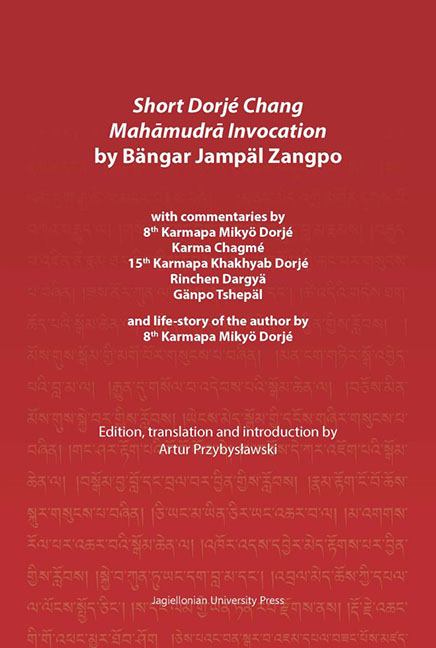 Short Dorjé Chang Mahāmudrā Invocation by Bängar Jampäl Zangpo
Short Dorjé Chang Mahāmudrā Invocation by Bängar Jampäl Zangpo Published online by Cambridge University Press: 14 October 2023
From time to time Buddha himself used to put his vast and various teachings in just a few words that were easy to remember and could stay in the minds of his students as a crucial guiding formula for their understanding, practice and finally realization. Later Buddhist masters followed this manner proving their realization and understanding of dharma by their ability to convey deep and vast meaning in just a few words or stanzas of their instructions. In Kagyü tradition, that’s origin traces back to the Indian mahasiddha Tilopa, the examples are his famous six rules, Nāropa’s Concise Mahāmudrā, Four Dharmas of Gampopa up to Jampäl Zangpo’s text translated here (with commentaries) and many others that were composed before and later.
BIOGRAPHICAL SKETCH OF JAMPÄL ZANGPO
Information about the life of Jampäl Zangpo is very limited. His two biographies ‒ by the 8th Karmapa Mikyö Dorjé (karma pa mi bskyod rdo rje, 1507‒1554) translated in the appendix and by the 8th Situ (si tu paN chen chos kyi ‘byung gnas, 1700‒1774) ‒ are mainly praises that refer to very few historical details. Even the dates of his birth and death are unknown and from the fact that he was the main student ‒ as he is called “the heart son” ‒ of the 6th Karmapa (karma pa mthong ba don ldan, 1416‒1453), and a teacher of the 7th Karmapa (karma pa chos grags rgya mtsho, 1454‒1506), we can locate him roughly as living in the middle of the 15th century. From the fact that in his later years he started to teach the young 7th Karmapa who was twelve years old at that time, one can estimate the date of his death to have taken place roughly in the seventh decade of the 15th century. Most of the substantial information about his life comes from a very short biographical sketch that precedes praise that is three times longer in the monumental biographical cycle of the 8th Situ:
He was born in Dam Shung as the son of [his] father, who was a brother of Wang Gyawa Chökyi Rinchen, and [his] mother Chökyi Drölma. He learnt to read and write without any effort. He had a vision of eminent Tārā. In front of lama Chorinpa he received many empowerments and oral transmissions like the Diamond garland.
To save this book to your Kindle, first ensure [email protected] is added to your Approved Personal Document E-mail List under your Personal Document Settings on the Manage Your Content and Devices page of your Amazon account. Then enter the ‘name’ part of your Kindle email address below. Find out more about saving to your Kindle.
Note you can select to save to either the @free.kindle.com or @kindle.com variations. ‘@free.kindle.com’ emails are free but can only be saved to your device when it is connected to wi-fi. ‘@kindle.com’ emails can be delivered even when you are not connected to wi-fi, but note that service fees apply.
Find out more about the Kindle Personal Document Service.
To save content items to your account, please confirm that you agree to abide by our usage policies. If this is the first time you use this feature, you will be asked to authorise Cambridge Core to connect with your account. Find out more about saving content to Dropbox.
To save content items to your account, please confirm that you agree to abide by our usage policies. If this is the first time you use this feature, you will be asked to authorise Cambridge Core to connect with your account. Find out more about saving content to Google Drive.